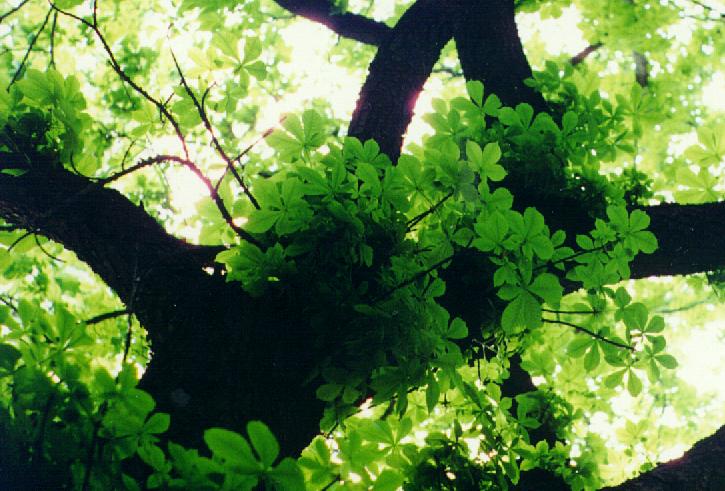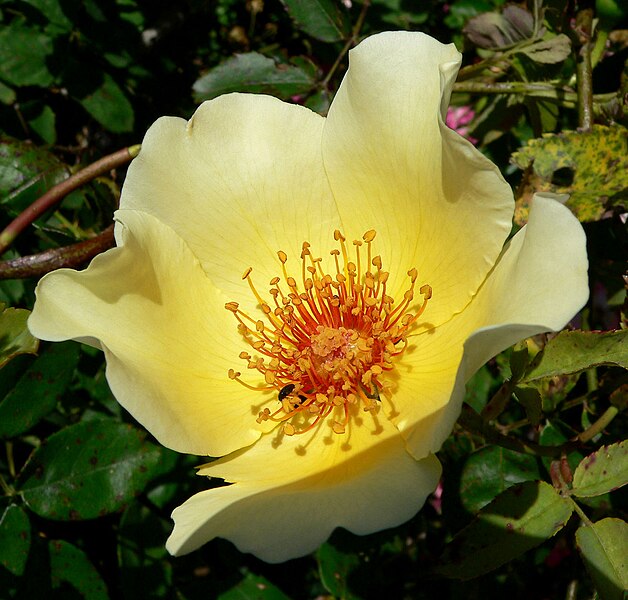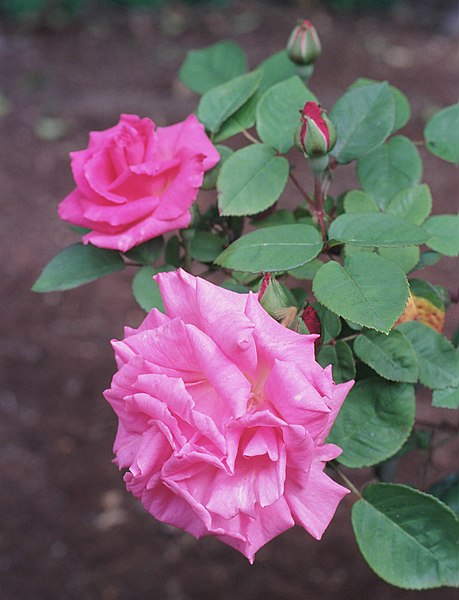.
Leaves and trunk of Aesculus hippocastanum (common horse-chestnut), Estrela Garden, Lisbon: photo by Alvesgaspar, 2007
Twenty-some years ago, I read Graham Stuart Thomas's
"Colour in the Winter Garden." I didn't plant
a winter garden, but the book led on to his
rose books: "The Old Shrub Roses," "Shrub Roses
of Today," and the one about climbers and ramblers.
By the corner of the arbor I planted the splendid
Nevada (a Spanish rose, Pedro Dot) and on the arbor
yellow Lawrence Johnston -- I've never known
anyone who made a real success of that. Then
a small flowered rose (like a blackberry in flower),
whose name I forget, and then, oh loveliness, oh
glory, Mme. Alfred Carrière, white, with a faintest
blush of pink, and which will bloom even on a
north wall. I used to shave and gaze down into her --
morning kisses. The day Robert Kennedy died, a
green and evil worm crawled out of a bud. I killed
it, a gardening Sirhan Sirhan.
At the corner of the house Rosa Mutabilis fluttered
its single, changeable wings. My favorite, perhaps.
Rosa "Golden Wings", San Jose Heritage Garden: photo by Stan Shebs, 2005
Then, in the border, along the south side of
the white house, Golden Wings (a patented rose --
did you know you can patent roses? Well, you can);
prickly, purplish Rose de Rescht; Souvenir
de la Malmaison (named by a Russian Grand Duke in
honor of the Empress Joséphine, Empress of Rosarians);
Mabel Morrison, lifting her blowsy white blooms
to the living-room windows.
Then Georg Arends, whose silver-pink petals
uniquely fold into sharp points (or is Georg
my favorite?).
And darkly brooding Prince Camille de Rohan, on
which, out of a cloudless sky, a miraculous rain
once fell. (But I'm forgetting Gloire de Dijon,
Dean Hole's favorite rose.)
Then the smallest, most delicate, delectable
of all, Rose de Meaux. Alas, it pined away.
Rosa "Zephirine Drouhin", gr. Borbonianas, sect. Chinensis, Real Jardin Botánico, Madrid: photo by A. Barra, 1988
And elsewhere more: Rosa Gallica, the striped
and the pink, the Pembertons, Persian yellow,
and unforgettable cerise Zéphirine Drouhin.
And a gray rose, Reine des Violettes. Sweet-
brier, Mme. Piere Oger, Variegata di Bologna,
"like raspberries and cream." And more,
whose names escape me.
I went by there Sunday last and they're gone, all
gone, uprooted, supplanted by a hateful "foundation
planting" of dinky conifers, some pointed, some
squatty roundish. I put a curse on it and them.
Aesculus hippocastanum (common horse-chestnut), flowers: photo by Bogdan Gíusca, 2005
On either side of the front walk there towered two
old horse-chestnut trees. I loved their sticky,
unfurling leaves, and when they bore their candles
it was magic, breath-catching, eye-delighting. Cut
down, cut down. What kind of man cuts down trees
that took all those years to grow? I do not
understand.
Oh, well, it's his house now, and I remove the
curse, but not without a hope that Rose de Rescht
and the rugosas gave him a good scratching. He
deserved it.
But oh dear: I forgot the five Old China Monthly
roses, and I always wish I'd planted Félicité
et Perpétue -- it's their names I like. And
Climbing Lady Hillingdon.
(But the Garland grown as a fountain seemed
somehow beyond me.)

Rosa "Félicité et Perpétue", gr. Sempervirens, sect. Synstaelae, Real Jardin Botánico, Madrid: photo by A. Barra, 1988
There are roses and roses, always more roses.
It's the horse-chestnut trees I mind.
It's the horse-chestnut trees I mind.

Aesculus hippocastanum (common horse-chestnut), Kiev: photo by K. Eno, 2006
James Schuyler: from Last Poems in Collected Poems, 1993
("I have a special thing about roses" -- Letters)





